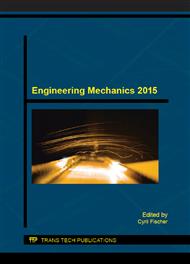[1]
Knobloch J, Holub M, Kolouch M. Laser tracker measurement for prediction of workpiece geometric accuracy. In: Fuis V, editor. Eng. Mech. 2014 - 20th Int. Conf., Svratka: Brno University of Technology Institute of Solid Mechanics, Mechatronics and Biomechanics; 2014, p.296.
Google Scholar
[2]
Holub M, Michalicek M, Vetiska J, Marek J. Prediction of Machining Accuracy for Vertical Lathes. In: Jablonski, R and Brezina T, editor. Mechatronics 2013 Recent Technol. Sci. Adv., Springer International Publishing Switzerland; 2013, p.41–8.
DOI: 10.1007/978-3-319-02294-9_6
Google Scholar
[3]
Holub M, Pavlik J, Opl M, Blecha P. Identification of Geometric Errors of Rotary Axes in Machine Tools. In: Jablonski, R and Brezina T, editor. MECHATRONICS Recent Technol. Sci. Adv., HEIDELBERGER PLATZ 3, D-14197 BERLIN, GERMANY: SPRINGER-VERLAG BERLIN; 2011, p.213.
DOI: 10.1007/978-3-642-23244-2_25
Google Scholar
[4]
Marek J, Blecha P. Compensation of axes at vertical lathes. Recent Adv. Mechatronics 2008-2009, springer berlin; 2009, p.371–6.
DOI: 10.1007/978-3-642-05022-0_63
Google Scholar
[5]
Abele E, Altintas Y, Brecher C. Machine tool spindle units. CIRP Ann - Manuf Technol 2010; 59: 781–802.
DOI: 10.1016/j.cirp.2010.05.002
Google Scholar
[6]
Uhlmann E, Hu J. Thermal Modelling of a High Speed Motor Spindle. Procedia CIRP 2012; 1: 313–8.
DOI: 10.1016/j.procir.2012.04.056
Google Scholar
[7]
Jędrzejewski J, Kowal Z, Kwaśny W, Modrzycki W. High-speed precise machine tools spindle units improving. J Mater Process Technol 2005; 162-163: 615–21.
DOI: 10.1016/j.jmatprotec.2005.02.149
Google Scholar
[8]
Xu C, Zhang J, Feng P, Yu D, Wu Z. Characteristics of stiffness and contact stress distribution of a spindle–holder taper joint under clamping and centrifugal forces. Int J Mach Tools Manuf 2014; 82-83: 21–8.
DOI: 10.1016/j.ijmachtools.2014.03.006
Google Scholar
[9]
Matsubara A, Yamazaki T, Ikenaga S. Non-contact measurement of spindle stiffness by using magnetic loading device. Int J Mach Tools Manuf 2013; 71: 20–5.
DOI: 10.1016/j.ijmachtools.2013.04.003
Google Scholar
[10]
Fujimaki K, Mitsui K. Radial error measuring device based on auto-collimation for miniature ultra-high-speed spindles. Int J Mach Tools Manuf 2007; 47: 1677–85.
DOI: 10.1016/j.ijmachtools.2007.01.002
Google Scholar
[11]
Fiala Z, Piska M, Jaros A. On the analysis of the sound spectrum at machining of the glass-polyester composite material. MM Sci J (2014).
DOI: 10.17973/mmsj.2014_03_201403
Google Scholar
[12]
Brezina T, Hadas Z, Vetiska J. Simulation behavior of machine tool on the base of structural analysis in multi-body system. Proc. 15th Int. Conf. Mechatronics, MECHATRONIKA 2012, (2012).
Google Scholar
[13]
Brezina T, Vetiska J, Hadas Z, Brezina L. Simulation modelling and control of mechatronic systems with flexible parts. Mechatronics Recent Technol. Sci. Adv., 2011, p.569–78.
DOI: 10.1007/978-3-642-23244-2_69
Google Scholar


